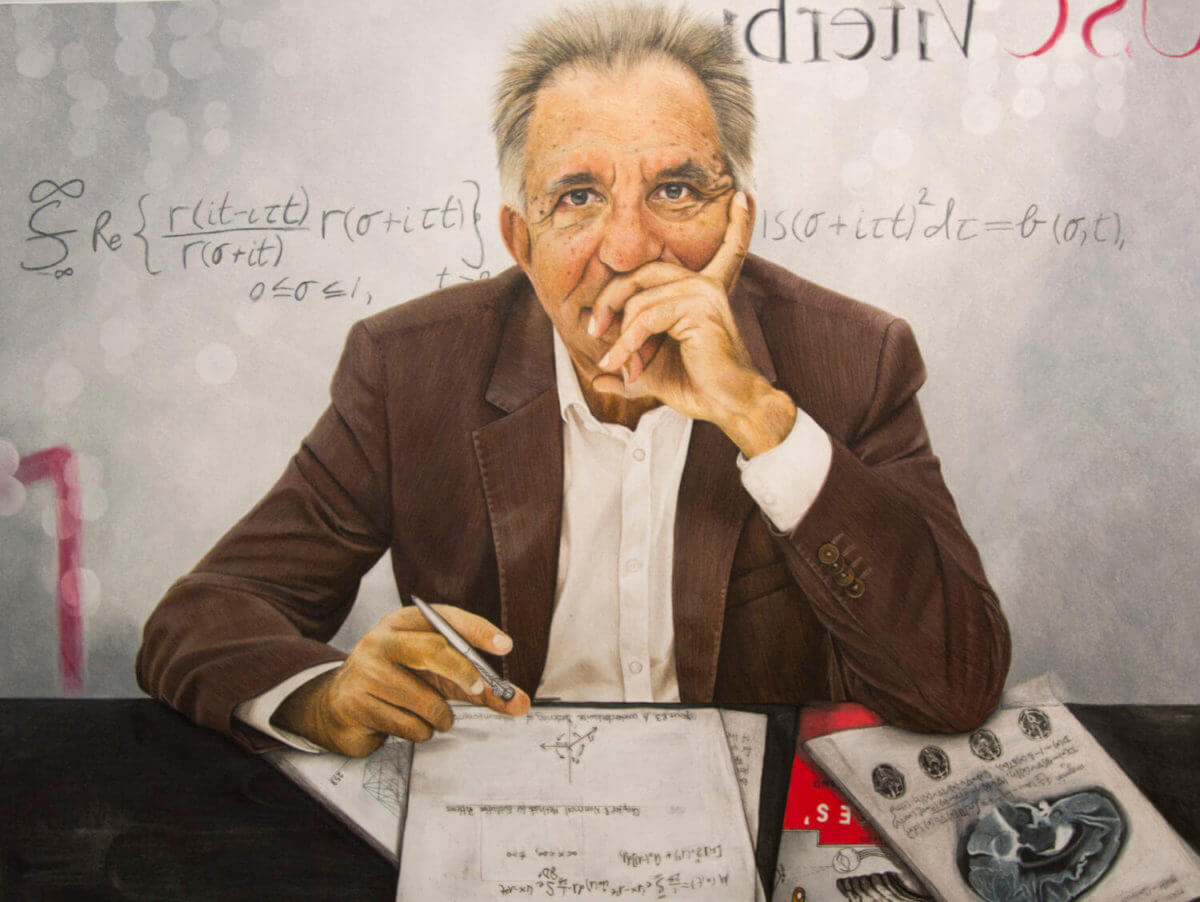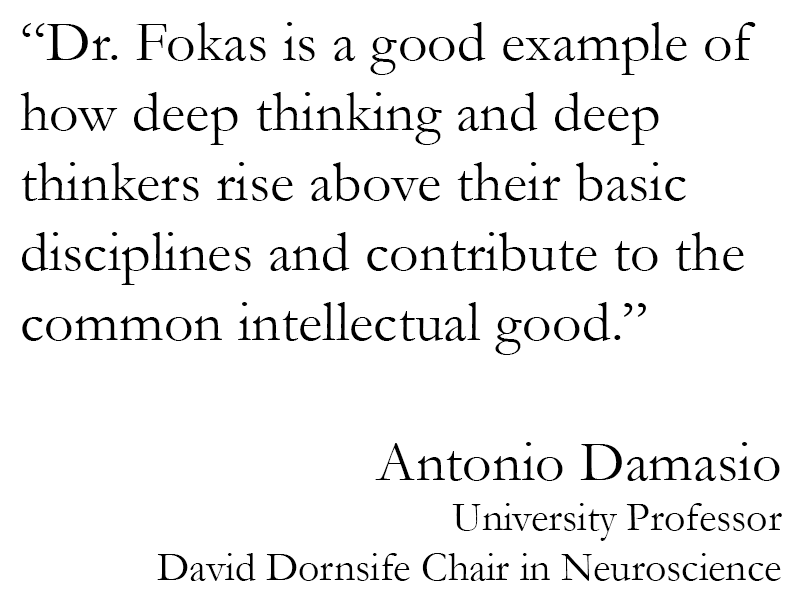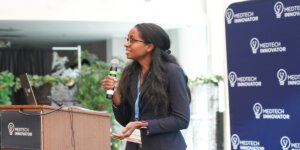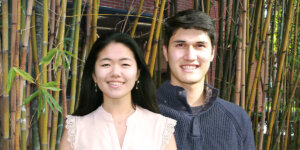
Thanasis Fokas’s work spans mathematics, engineering, neuroscience, art, philosophy and the unconscious mind. Illustration by Andreea Berindei
First Secret
“Do not solve a problem that someone else can solve. After all, what is important is for science to advance. If someone else can solve it, science does not need you.”
“Thanasis Universalis,” as his closest friends call him, wrestles with math that has universal consequences. From his time as an undergraduate student in aeronautics at Imperial College (1975) to his Ph.D. in applied mathematics from the California Institute of Technology (1979) and his M.D. from the University of Miami School of Medicine (1986), Fokas has done groundbreaking work in mathematics, mathematical physics, fluid mechanics, medical imaging and protein folding. These days, he splits his time between USC, the Academy of Athens and the University of Cambridge where he holds the Chair of Nonlinear Mathematical Science at the Department of Applied Mathematics and Theoretical Physics. At USC Viterbi, he is a visiting professor in the Ming Hsieh Department of Electrical Engineering.
This semester, he is teaching a USC Viterbi course on “The Fokas Method and Water Waves” which will provide a mathematical analysis of water waves using Fokas’s unmistakable method for solving linear partial differential equations.
This is a powerful tool that scientists and engineers like USC Viterbi professor Costas Synolakis use to model the erratic behavior of water waves such as the Greenland tsunami in June, 2017 — one of the tallest tsunamis in recorded history.
What is it about Fokas that makes him such a unique thinker? A man whose computer-based algorithms in medical imaging can construct powerful images of the brain much faster and more accurately than commercial machines, but who does his work with pen and paper to the sound of Verdi’s Requiem.
Second Secret
“Choose problems based on aesthetics and universal importance, always seeking quality, using the deep interplay between beauty, simplicity and complexity as a criterion. Mathematics points directly to the fundamental structure of the universe, which is ultimately written in the language of mathematics.”
Among the Millennium problems, the Riemann Hypothesis formulated by Riemann in 1859 is the holy grail of mathematics. Most mathematicians would trade their souls with Mephistopheles for a proof. The Clay Mathematics Institute has offered $1 million to anyone who can solve it.
In very simple terms, the Riemann Hypothesis is mostly about the distribution of prime numbers, the atoms of arithmetic. Cell phones essentially wouldn’t work without some properties of primes that allow multiple digital signals to work on the same frequency band.
Many computing algorithms, especially in cryptography, use prime numbers and their distributional properties to keep things such as credit cards secure. Most of these are formulated assuming the hypothesis is true, meaning that a number of algorithms used in internet encryption are mere unproven hypotheses. Proof or disproof of Riemann will allow us to test the validity of those algorithms.
 So how does one attack the most celebrated open problem in the history of mathematics? By way of solving another, of course, and a little dash of rebellion against conventional wisdom.
So how does one attack the most celebrated open problem in the history of mathematics? By way of solving another, of course, and a little dash of rebellion against conventional wisdom.
Closely related to Riemann, and second only in significance, is the Lindelöf Hypothesis, which, according to experts, is an even bigger mathematical monster to slay. In 2017, Fokas proved a slight variant of Lindelöf using a completely new and counterintuitive method to the classical approach followed so far. In doing so, he has gotten closer to solving Reimann than any of his contemporaries and achieved his greatest contribution to the field.
Third Secret
“Conventional mathematical wisdom says compete with your contemporaries, but never, ever compete with the classics, for nothing escapes the classics. But that is conventional wisdom.”
He doesn’t care where one science ends and the other begins,” is the way Nicholas Protonotarios, a member of Fokas’s Center for Mathematics and Medical Imaging at the Academy of Athens, described his work. “He treats mathematics, physics, engineering, biology, medicine and neuroscience as a continuum. That is the beauty of Fokas.”
His lifelong friend, USC Viterbi Dean Yannis Yortsos, calls him “the ultimate interdisciplinary scientist.”
In 1997, he added a new indispensable armament to the arsenal of tools scientists and engineers can use to solve an entire class of problems. The Fokas Method has completely supplanted transform methods discovered in the 18th century and used for over 250 years to solve linear partial differential equations.
In the process, it has made a number of other classical techniques, including the Wiener-Hopf method, obsolete. A recent editorial in the “Society for Industrial and Applied Mathematics (SIAM) Review,” compares the impact of the Fokas Method in mathematics with that of the “Fosbury flop” in the high jump.
Today professors teach the Fokas Method at a growing number of universities, including USC.
Fourth Secret
“Explore different areas. The statement that one cannot be both deep and broad is a myth. Actually, the importance of being a polymath is that it allows one to make remote associations, and thus to understand the deeper essence of things. Understanding is nothing more than elucidating associations.”
“Dr. Fokas is a good example of how deep thinking and deep thinkers rise above their basic disciplines and contribute to the common intellectual good,” said neuroscientist and author of Self Comes to Mind: Constructing the Conscious Brain, Antonio Damasio, director of USC’s Brain and Creativity Institute.
Take Fokas’s collaboration with his mentor Israel Gelfand, one of the giants of 20th-century mathematics whose research laid the mathematical framework for the imaging abilities of MRI and CT scanners. While working with Gelfand on protein folding, Fokas discovered unexpected topological properties in an important class of proteins called beta proteins. Following their seminal works, scientists can now predict the 3-D structure of these proteins with a success rate of 80 percent, accelerating more effective, targeted drug designs.
The work with Gelfand led Fokas to unearth the deep mathematics that play a crucial role in SPECT medical imagining technology and Magnetoencephalography (MEG) used to map brain activity. After nearly fifteen years of research, his group at the Academy of Athens can now reconstruct SPECT images faster and more accurately than existing commercial systems.
“Thanasis is a mathematical genius,” said renowned physical chemist, Costas Vayenas, a member of the National Academy of Engineering. “This, combined with his strong engineering, physical, biological and medical backgrounds, make him extremely effective in attacking problems over a very wide range of topics.”
Fifth Secret
Set aside two months in a year away from mathematics, but use this time productively. During this period, I only read books in four categories: neuroscience, music, painting, and the ancient Greeks.
For Fokas working on one open problem in a particular field can surreptitiously lead to solving one in another. The result? Math beautifully reveals a hierarchy of imperatives in our understanding of the universe – each success buys an admission ticket to a more difficult problem.
So ten years ago, when Vayenas proposed that the force that keeps the three elementary particles in protons and neutrons together is actually relativistic gravity, not strong force as universally agreed, Fokas was intrigued. If Vayenas were right, it would be one of the most spectacular breakthroughs in the history of natural sciences since Albert Einstein’s special relativity in 1905 and Niels Bohr’s model of the H atom in 1913.
Sixth Secret
“Be overly optimistic. It is a moral obligation to enjoy the great gift of life. Be mentally resilient because failures are inevitable and crisis will come. The question is not what happens to you but what you do with what happens to you.”
Experiments, like those performed at CERN, the European Organization for Nuclear Research, suggest that each proton and neutron consists of three elementary particles. But, what is the force that keeps these particles together? No one so far has derived a mathematical formula for it, which for obvious reasons is simply called the strong force.
Motivated by some earlier work of Einstein, Vayenas and Fokas came up with a formula for this force using a Bohr type model and obtained several early results that astonishingly agree almost perfectly with experiments.

(L to R): A. Fokas, USC Viterbi Dean Yannis Yortsos and Costas Vayenas at Yortsos’s induction as an associate member of the Academy of Athens. Photo courtesy of Yannis Yortsos.
Fokas, in collaboration with experts in general relativity, is now attempting to derive Vayenas’s formula. If he succeeds, get ready for new editions of physics textbooks. An alternative, simpler theory to two of the fundamental forces of nature, strong force and weak force, will emerge.
Crisis did come to Fokas this summer when his heart literally came under the knife. Yet, with astonishing optimism and untapped reserves, he continued to work on these problems while recovering from a 7.5 hours heart surgery at Yale University. In Fokas’s mind, there is no requiem for an unsolved problem.
“There’s an unbelievable drive in him,” said his friend Evangelos Angelakos, shipping tycoon and former mayor of the island of Oinousses. “He won’t let go. He pulls from a reservoir of inspired knowledge that includes opera, painting and philosophy and he bases his life on truth and sharing. That is his secret.”
Seventh Secret
“Protect your creative time at all cost. I protect my time as I protect my three children.”
The work of a mathematician is monastic in nature. Straddling the chasm between the concrete, tangible universe and infinity is a lonely endeavor. Is it even possible to speak of multiple infinities, even an infinite number of infinities? Questions that have placed some mathematicians on the wrong side of authority and on trial for treason. Questions that cannot withstand pedestrian distractions such as binge watching Netflix or replying to lengthy emails. Fokas essentially does not watch TV and keeps his emails very short. What remains of his time, he spends investing in people. He’s classical in this way. In the expedition for knowledge, Fokas believes you can’t hold on to science with one hand and technology with the other so that you have no hand left to reach for the human spirit which he says is “the greatest expedition”.
Who knows how many unsolved math and physics problems will come tumbling down in Fokas’ lifetime? When they do, it will happen in silence and solitude, not in a big Oscar moment. The centuries-old mathematical pillar will quietly yield to the pen and the floodgates for a new generation of problem solvers will be open. The mathematician will then sail quietly into the twilight of his beloved Greek island, Cephalonia, the home of Odysseus, to ponder the beauty of the Ionian Sea. Like someone being swept along by a beautiful wave.
Then, very slowly, the world will begin to change and the name will resurface. Athanasios, after all, means immortal in Greek.
Published on September 7th, 2017
Last updated on May 16th, 2024










